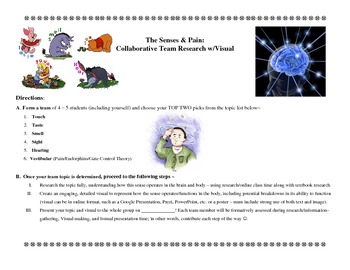Psychology Collaborative Research: The 5 Senses & Vestibular System
Engaging Language Arts and Psychology
188 Followers
Grade Levels
9th - 12th, Higher Education, Adult Education, Homeschool
Subjects
Resource Type
Standards
CCSSSL.9-10.1
CCSSSL.9-10.1a
CCSSSL.9-10.1b
CCSSSL.9-10.1c
CCSSSL.9-10.1d
Formats Included
- PDF
Pages
1 page
Engaging Language Arts and Psychology
188 Followers
Description
This is a detailed step-by-step, newly revised and graphic activity to be used in Psych I , II, or AP Psychology course in a unit on the five senses and biological foundations in Psychology, including the vestibular system. The activity could take 2-3 class periods, depending on the availability of research/resources, how much time you feel the students need for the collaborative research step as well as the amount of time you feel the require for the visual-creation step and preparing to present to the whole group.
I have used this with great success (and FUN!) in my Psych I course in the past. It essentially is a small, cooperative group activity, where students will convene to research/analyze and assess their given/chosen "sense." This provides students the opportunity to formally present in front of the class the following day.
In this way, students are invited to develop the Common Core Standards of 21st Century Skills, including communication and , collaboration, problem-solving, media literacy,AND critical thinking; they also will be working within the higher levels of Bloom's Taxonomy (eg. moving beyond understanding to application, analysis, and evaluation)!
Please enjoy, and I look forward to your feedback!
I have used this with great success (and FUN!) in my Psych I course in the past. It essentially is a small, cooperative group activity, where students will convene to research/analyze and assess their given/chosen "sense." This provides students the opportunity to formally present in front of the class the following day.
In this way, students are invited to develop the Common Core Standards of 21st Century Skills, including communication and , collaboration, problem-solving, media literacy,AND critical thinking; they also will be working within the higher levels of Bloom's Taxonomy (eg. moving beyond understanding to application, analysis, and evaluation)!
Please enjoy, and I look forward to your feedback!
Total Pages
1 page
Answer Key
Does not apply
Teaching Duration
2 days
Report this resource to TPT
Reported resources will be reviewed by our team. Report this resource to let us know if this resource violates TPT’s content guidelines.
Standards
to see state-specific standards (only available in the US).
CCSSSL.9-10.1
Initiate and participate effectively in a range of collaborative discussions (one-on-one, in groups, and teacher-led) with diverse partners on grades 9–10 topics, texts, and issues, building on others’ ideas and expressing their own clearly and persuasively.
CCSSSL.9-10.1a
Come to discussions prepared, having read and researched material under study; explicitly draw on that preparation by referring to evidence from texts and other research on the topic or issue to stimulate a thoughtful, well-reasoned exchange of ideas.
CCSSSL.9-10.1b
Work with peers to set rules for collegial discussions and decision-making (e.g., informal consensus, taking votes on key issues, presentation of alternate views), clear goals and deadlines, and individual roles as needed.
CCSSSL.9-10.1c
Propel conversations by posing and responding to questions that relate the current discussion to broader themes or larger ideas; actively incorporate others into the discussion; and clarify, verify, or challenge ideas and conclusions.
CCSSSL.9-10.1d
Respond thoughtfully to diverse perspectives, summarize points of agreement and disagreement, and, when warranted, qualify or justify their own views and understanding and make new connections in light of the evidence and reasoning presented.


